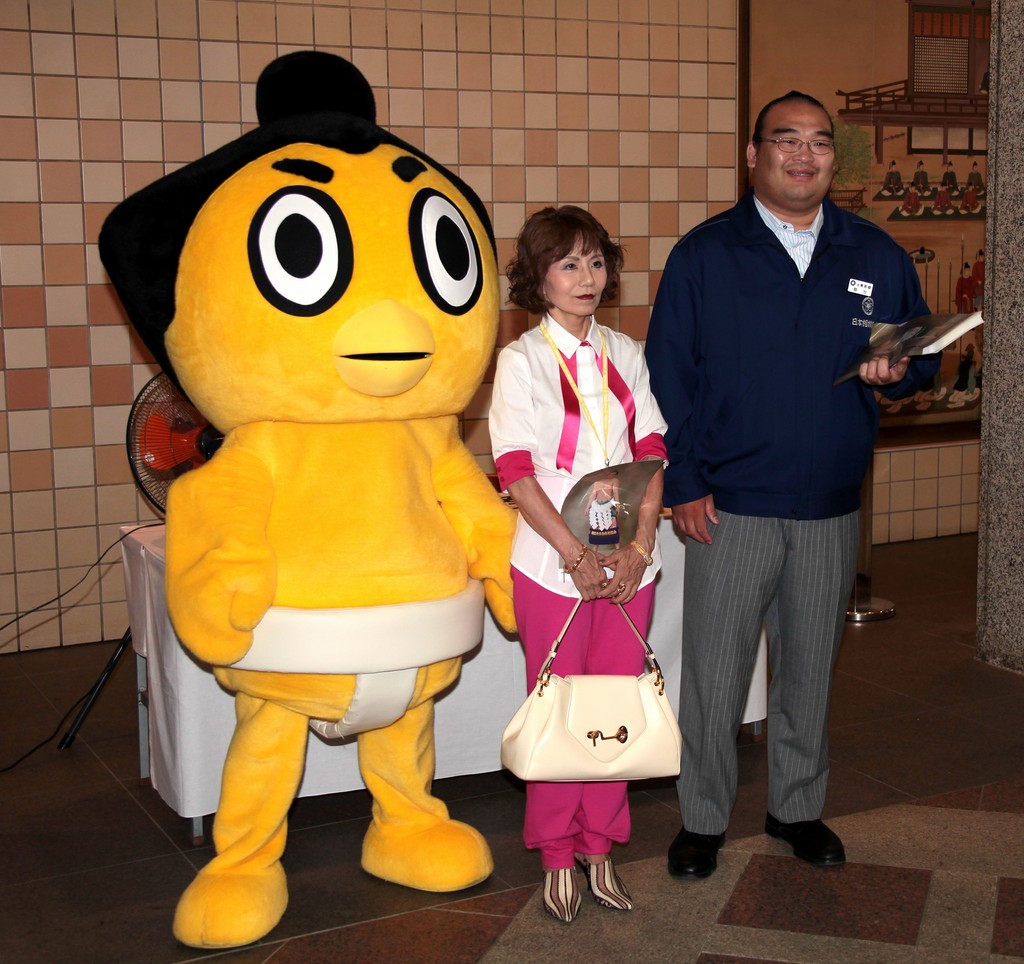SEANCE DE DEDICACE AVEC ANCIEN YOKOZUNA
Yokozuna (横綱) est le rang (et non pas le niveau) le plus élevé que peut atteindre un lutteur sumo.
Une fois promu, le yokozuna ne peut plus perdre son titre, mais on attend de lui qu'il se retire s'il ne peut plus obtenir des résultats dignes de son rang. Le terme yokozuna vient du symbole le plus visible de leur rang : une large (yoko) corde (tsuna), similaire au shimekazari des sanctuaires shinto, portée autour de la taille lors de la cérémonie de l'entrée sur le ring (dōhyō-iri).
Histoire
L'origine du rang de yokozuna reste floue et deux légendes différentes s'affrontent :
- Selon l'une, un lutteur du IXe siècle nommé Hajikami accrocha un shimenawa autour de sa taille comme handicap et mis ses opposants au défi de le toucher, créant du même coup la lutte sumo comme nous la connaissons aujourd'hui.
- Selon l'autre légende, le lutteur légendaire Shiganosuke Akashi accrocha un shimenawa autour de sa taille en 1630 en signe de respect lors d'une visite à l'Empereur et aurait reçu le premier titre de yokozuna à titre posthume. Il y a très peu d'éléments qui permettent de prouver que l'une des deux légendes est vraie, mais on sait que depuis 1789, les yokozuna depuis Kajinosuke Tanikaze sont représentés en ukiyo-e portant le shimenawa.
---------------------------------------
Yokozuna (横綱) is the highest rank in sumo.
The name literally means "horizontal rope" and comes from the most visible symbol of their rank, the rope (綱 tsuna) worn around the waist. The rope is similar to the shimenawa used to mark off sacred areas in Shinto, and like the shimenawa it serves to purify and mark off its content. The rope, which may weigh up to 20 kilograms (44 lb), is not used during the matches themselves, but is worn during the yokozuna's dohyo-iri ring entrance ceremony. Yokozuna are in many ways the face of sumo, and the way they comport themselves is highly scrutinized as it is seen as reflecting on the image of sumo as a whole.
History of yokozuna
The birth of the rank of yokozuna is unclear, and there are two competing legends. According to one, a 9th-century wrestler named Hajikami tied a shimenawa around his waist as a handicap and dared any to touch it, creating sumo as it is now known in the process. According to the other, legendary wrestler Akashi Shiganosuke tied the shimenawa around his waist in 1630 as a sign of respect when visiting the Emperor, and was posthumously awarded the title for the first time. There is little supporting evidence for either theory—in fact, it is not even certain that Akashi actually existed—but it is known that by November 1789, yokozuna starting from the fourth yokozuna Tanikaze Kajinosuke and the fifth yokozuna Onogawa Kisaburō were depicted in ukiyo-e prints as wearing the shimenawa. These two wrestlers were both awarded yokozuna licences by the prominent Yoshida family. Before the Meiji Era, the title yokozuna was conferred on ōzeki who performed sumo in front of the Shogun. This privilege was more often determined by a wrestler's patron having sufficient influence rather than purely on the ability and dignity of the wrestler. Thus there are a number of early wrestlers who were, by modern standards, yokozuna in name only. In these early days yokozuna was also not regarded as a separate rank in the listings, but as an ōzeki with special dispensation to perform his own ring entering ceremony. At first, the Yoshida family and a rival family, Gojo, fought for the right to award a wrestler a yokozuna licence. The Yoshida family won this dispute, because the 15th yokozuna Umegatani Tōtarō I, one of the strongest wrestlers, expressed his wish that he be awarded a licence by the Yoshida family in February 1884, and Gojo licences are no longer recognized officially. In May 1890, the name yokozuna was written on the banzuke for the first time due to the 16th yokozuna Nishinoumi Kajirō I's insistence that his yokozuna status be recorded. In February 1909, during the reigns of the 19th yokozuna, Hitachiyama Taniemon, and the 20th, Umegatani Tōtarō II, it was officially recognized as the highest rank. Since the establishment of the Yokozuna Deliberation Council (横綱審議委員会 Yokozuna-shingi-iinkai) on 21 April 1950, wrestlers have been promoted to yokozuna by the Japan Sumo Association. The first yokozuna promoted by the Sumo Association was the 41st yokozuna Chiyonoyama Masanobu.
